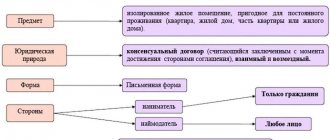What is legal invalidity
The area of concluding transactions relates to civil law: this means that both parties must perform their actions in the designated legal field (strictly within the framework of current legislation and in accordance with the requirements of regulations).
What are the relationships between fictitious, imaginary and sham transactions ?
As for transactions, they are characterized by 4 significant categories that determine their legal existence:
- parties (participants, subjects of the transaction);
- the external expression of the will of the participants is the subjective area of the transaction;
- transaction form;
- conditions (content, subject of the transaction).
Any non-compliance with the law in at least one of these elements will invalidate the transaction.
On what grounds can a transaction be declared invalid ?
Admissibility of out-of-competition challenge
Some authors believe that our legal system has no place for non-competitive challenges to transactions.
They explain this by the fact that in order to invalidate transactions made to the detriment of creditors, there are special “bankruptcy” grounds provided for by Chapter III.1 of the Federal Law “On Insolvency (Bankruptcy)” (hereinafter referred to as the Bankruptcy Law). That is, the creditor must first initiate the initiation of a bankruptcy case against his debtor and only then, within the framework of this case, through an arbitration manager or independently challenge the defective transaction. In this case, all creditors, and not just one, receive a positive effect from challenging the transaction.
One cannot agree with this approach even from a political and legal point of view. Not all creditors have the right to initiate bankruptcy proceedings and not all have the ability to pay the considerable costs of such a case. For example, creditors for losses in the form of lost profits cannot be petitioners in a bankruptcy case. How then can they protect their rights if the debtor has withdrawn all his assets?
Obviously, creditors must be able to resist abuses by debtors. Sometimes the only option is to challenge the transaction out of competition. Moreover, this legal institution has a centuries-old history. It was known in Roman law as the “Paulian claim” (actio Pauliana).
Yes, such a claim is selfish, since it is filed in the interests of only one creditor. However, through the mechanism of consolidated enforcement proceedings, the interests of other creditors who have already received writs of execution will be taken into account.
Of course, creditors who do not yet have writs of execution may find themselves out of business. But would anything change for them if the withdrawn asset remained in the ownership of a third party? As they say, law loves active people.
Types of invalid transactions
The possibilities of breaking the law when concluding transactions are quite extensive, this determines the classification of their invalidity. Depending on the order in which their invalidity is revealed, they can be:
- disputable - their legal inconsistency will have to be proven during the judicial procedure;
- void - showing their invalidity immediately upon conclusion.
Most often, as practice shows, imaginary and feigned transactions are made. They are considered void – invalid immediately from the moment they are committed. During these transactions, the expression of will is violated - the actual actions of the parties do not correspond to the real will of the parties.
What are the accounting, auditing and legal approaches when establishing criteria for recognizing transactions as imaginary and sham ?
Who has the right to claim
Some courts do not recognize the creditor as a proper plaintiff and refuse to file a claim to challenge the transaction out of competition.
Their logic is as follows. Clause 3 of Article 166 of the Civil Code of the Russian Federation states: “The requirement to apply the consequences of the invalidity of a void transaction has the right to be presented by a party to the transaction, and in cases provided for by law, also by another person.” The creditor is neither a party to the transaction nor “another person”, since the law does not have a direct rule that would give the creditor the right to challenge the transaction between its debtor and a third party.
This approach is wrong. Such courts do not take into account the explanations given in paragraph 78 of the Resolution of the Plenum of the Supreme Court of the Russian Federation dated June 23, 2015 N 25 “On the application by courts of certain provisions of Section I of Part One of the Civil Code of the Russian Federation,” which says: “Based on the systemic interpretation of paragraph 1 of Article 1, paragraph 3 of Article 166 and paragraph 2 of Article 168 of the Civil Code of the Russian Federation, the claim of a person who is not a party to a void transaction for the application of the consequences of its invalidity may also be satisfied if civil legislation does not establish another method of protecting the rights of this person and its protection is possible only by applying the consequences of the invalidity of the void transaction transactions."
A creditor who has lost the opportunity to foreclose on the debtor’s property cannot protect his right except through a lawsuit aimed at returning the seized property to the debtor. Therefore, he has the right to challenge the transaction between his debtor and a third party out of competition.
Features of an imaginary transaction
Civil Code of the Russian Federation in Part 1 of Art. 170 calls an imaginary transaction, which is concluded without any incentive to create real legal results, solely “for show,” and both parties are well aware of this. This is by no means an aimless transaction, it’s just that its purpose does not correspond to the stated one, it is hidden from external observers because it is illegal.
FOR EXAMPLE . The company is facing inevitable bankruptcy, and it “rewrites” part of its assets to another person. In this case, the property does not actually change hands at all, because the real purpose of the transaction is precisely to preserve it. After all, in the event of bankruptcy, assets will be sold for debts.
Another common example of a sham transaction is disguising a bribe. A “sale” of valuable property is formalized, only in reality the buyer does not pay any money agreed upon in the terms of the transaction.
How to distinguish an imaginary deal
Imaginary transactions have features that characterize them, in contrast to “normal” legal transactions, as well as from other types of invalid ones. Some of the features will certainly appear, and some may or may not occur.
Characteristic features of imaginary transactions:
- There is a violation of the will, but the form is strictly observed and even excessively (for example, documents that do not require confirmation are certified by a notary, things that can be discussed orally are drawn up in writing, etc.).
- After the transaction is concluded, its terms are not fulfilled or this occurs only in relation to part of the content. The transaction is carried out only on paper.
- Both parties do not intend to fulfill the terms of the transaction, having agreed on this before its completion.
- The real purpose of concluding such a transaction is contrary to legal norms.
Indirect features may also indicate that the transaction is sham:
- dependent, close or even family ties between the parties to the transaction;
- coincidence of legal addresses of the parties-legal entities;
- some persons or the entire composition of the founders of the organizations concluding the transaction are the same;
- For a certain period of time, no real actions occur that will inevitably cause the terms of the transaction to be fulfilled.
FOR EXAMPLE. An imaginary transaction was concluded for the purchase and sale of residential real estate. If we consider its validity in court, they will ask who is currently registered or living in the alienated property - the buyer or still the seller or their representatives. The court will also find out whether contracts with housing and communal services have been renegotiated, who pays for utilities, etc. The question of the circumstances surrounding the transfer of money will also be raised.
Consequences of recognizing the invalidity of an imaginary transaction
Since the parties did not actually transfer anything to each other during the imaginary transaction, they should not return anything. Having proved the legal inconsistency of the transaction, the court will only cancel the transaction itself. And what this cancellation will lead to does not matter, since the legislative “status quo” must be restored.
FOR EXAMPLE . The citizen was sued, demanding payment of the debt. Knowing that he will be forced to fulfill the demand, wanting to avoid having his apartment seized, he enters into a deal to “sell” it to a person he trusts. In fact, he continues to live in an apartment that does not belong to him only formally. The court proves that the deal is sham. What's changing? The ownership that has been changed is returned. Now the creditor will be able to recover his funds by seizing and selling the apartment at auction, which will be carried out by the enforcement service. Please note that these consequences will occur if the apartment was sold after the creditor went to court. In a situation where the debtor has “insured himself” in advance, it will no longer be possible to prove anything, especially if a trusted person or relative has already resold the apartment legally.
IMPORTANT! If the court determines that there were no consequences for the transaction, it will be declared imaginary, regardless of whether proper registration has been completed or whether there are deviations from the norm (for example, the transaction has not yet been registered).
The imaginary deal was declared invalid, but what will happen to its participants, besides the return of the original rights? For those who made a sham transaction, liability may arise if additional charges are brought against them, for example, a police report for fraud.
Examples of common risky trades
Examples of the most common risky transaction scenarios in the real estate industry. When to be wary and what to pay attention to and check legal compliance:
- violation of privatization conditions - the seller of the apartment did not formalize privatization in the proper manner and in fact the property is owned by the state;
- buying an apartment that was inherited by the seller - the main risk here is that it is difficult to check all the other potential heirs who may subsequently make their claims on the property;
- the apartment is sold by a person recognized as incompetent - according to the law, only his legal representative can sell the apartment of an incompetent citizen with the permission of the guardianship authorities;
- the rights of minors have been violated - for example, parents bought an apartment using maternity capital and sell the apartment without allocating shares to the children; such a transaction is illegal.
- the real estate seller did not receive the consent of the spouse for the sale - the apartment was purchased during marriage, registered in the name of one of the spouses, he sells it without obtaining the consent of the second spouse.
- they are selling housing that they received as a gift - here it is important to understand whether the gift agreement was not a sham transaction covering up the purchase and sale of an apartment;
- sale of an apartment received under a rent agreement - even when purchasing an apartment under an executed rent agreement, it is difficult to completely protect yourself from the appearance of uninvited relatives or heirs of the renter; it is advisable to check such points in advance;
- the transaction is handled by a trusted person - potential risks in this case: improper execution of the power of attorney, whether the power of attorney was given by a person who was misled;
- sale of a share - pitfalls can be: disagreements with the owners of the remaining shares, possible disagreement of the guardianship authorities on the sale of the share if the shares belong to minors;
- an apartment is being sold by an elderly person - here it is important to check that the transaction is made in good faith, that the elderly person is not under pressure and is not misled.
Sham transactions and the nuances of their invalidity
A sham transaction is sometimes called a type of sham transaction. Part 2 art. 170 of the Civil Code of the Russian Federation thus characterizes a completed transaction, designed to replace in the eyes of the law another transaction, perhaps on completely different terms. A sham transaction always has two components:
- cover deal – one that is intended to play the “main role”;
- the one being covered up is the one from which the parties actually want to cause legal consequences.
FOR EXAMPLE.
1. One citizen buys a car from another. To simplify paperwork and reduce taxes, instead of completing a purchase and sale, as should be required by law, a transfer by power of attorney is executed. The money for the car is actually transferred to the seller.
2. A house is for sale, the seller and the buyer have agreed on a price of 950,000 rubles. A purchase and sale agreement is drawn up, which specifies a price of 300,000 rubles in order to reduce income tax.
The main differences between a sham transaction and an imaginary one:
- participants plan legal consequences, but not those guaranteed by the concluded deal;
- Only the pretended part of the transaction is invalid, and the true part will remain legally recognized if it complies with the law.
Legal consequences of invalidity of a sham transaction
If it is possible to prove that the transaction is fictitious, the consequences will be different from those caused by the cancellation of the fictitious one. In a sham transaction there is a share of true legal relations, which cannot be canceled if it is legal. Thus, the part of the deal that does not correspond to the real state of affairs will be canceled, and the very deal that the parties tried to disguise will come into force in its place.
Using the examples given above, let us consider what consequences will occur if these transactions are declared invalid:
- The new owner of the car will not actually be its owner; he cannot completely dispose of the car at his own discretion. After the expiration of the power of attorney, if it is not renewed, which the true owner has every right to do, the “buyer” of the car will completely lose ownership of it.
- If such a transaction is declared invalid, the buyer will be returned only the money indicated in the text of the contract - 300,000 rubles, even if in fact he transferred the entire 950,000 rubles to the seller. The house will remain the property of the seller.
Evidence of a fraudulent transaction
This is a particularly difficult task. Most often, the party affected by a sham transaction is the tax authorities. And since they are not participants in the transaction, they do not have the right to sue the real participants. But if the transaction was concluded between organizations covering up their actual financial affairs, tax authorities may require an audit and bring the violators to justice.
FOR EXAMPLE. The company purchased equipment from suppliers, indicating in the documents a price that was clearly below the market price. Thus, it is not a purchase or sale, but an actual donation of most of the goods. Donation between legal entities is impossible, so it will not be possible to restore the true transaction. The company will have to either return the goods to the suppliers, adding compensation, or pay the real price for it (thereby “without offending” the tax authorities).
What is the difference between applying the consequences of invalidity of a transaction and terminating a contract?
Termination should not be confused with the recognition of the contract as invalid and the application of the consequences of invalidity of the transaction. An agreement can be amended or terminated not only due to its invalidity, but also by agreement of the parties or by a court decision.
In the event of termination or change in the terms of the contract, the parties do not have the right to demand from each other to return what they received during the validity period of the contract. A court decision or agreement to terminate or change the terms of the contract begins to take effect from the moment it comes into force or is signed, respectively.
Let's return to the example of a marriage contract; above, we considered the case of declaring it invalid and returning the property.
If, for example, the spouses, of their own free will, decide to terminate the contract, then its effect will cease only after its termination. Property received during the period of its validity will not need to be returned to each other. But the terms of the terminated contract will no longer apply to property that they acquire in the future.
Therefore, in order to determine which claim to file in court: to declare a transaction invalid or to terminate or amend a contract, one should proceed from an understanding of the legal consequences.
Which transaction is voidable?
A transaction is a transaction as a result of which one party (individual or organization) acquires, loses or transforms any rights or obligations.
A voidable transaction is one that has two key features. The first is the possibility of legally challenging it through the courts. The second is that the plaintiff has the right to appeal to the courts.
The key feature of the term under consideration is the complexity of the legal interpretation, which resulted in the appearance of Resolution No. 25 of the Plenum of the Armed Forces of the Russian Federation, dated June 23, 2015. The document explains the rules for recognizing a transaction as voidable and regulates the procedure for making a court decision on this issue.
Limitation periods
The limitation period for voidable transactions is determined by the Civil Code of the Russian Federation and specifically by Article 181. It is equal to one year. This is the time period given to interested parties to file an application with the judicial authorities.
The date of counting the period for recognizing a voidable transaction as invalid is important for the issue under consideration. It begins either from the moment the illegal influence (threat, violence, misrepresentation) on one of the parties ceases or it is informed about the circumstances of the transaction that allow it to be considered unlawful.
It is necessary to note one more significant difference between voidable and void transactions. For the latter, the statute of limitations is set at 3 years. The term of voidable transactions, as already noted, is noticeably shorter and amounts to only 1 year.








